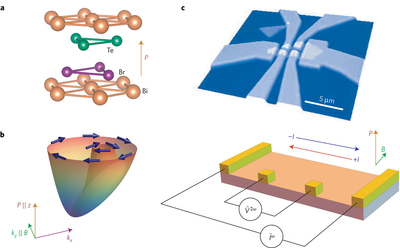PRESS RELEASE
- Research
- 2017
Bulk rectification effect in a polar semiconductor
Authors
T. Ideue, K. Hamamoto, S. Koshikawa, M. Ezawa, S. Shimizu, Y. Kaneko, Y. Tokura, N. Nagaosa & Y. Iwasa
Abstract
Noncentrosymmetric conductors are an interesting material platform, with rich spintronic functionalities and exotic superconducting properties typically produced in polar systems with Rashba-type spin–orbit interactions. Polar conductors should also exhibit inherent nonreciprocal transport, in which the rightward and leftward currents differ from each other. But such a rectification is difficult to achieve in bulk materials because, unlike the translationally asymmetric p–n junctions, bulk materials are translationally symmetric, making this phenomenon highly nontrivial. Here we report a bulk rectification effect in a three-dimensional Rashba-type polar semiconductor BiTeBr. Experimentally observed nonreciprocal electric signals are quantitatively explained by theoretical calculations based on the Boltzmann equation considering the giant Rashba spin–orbit coupling. The present result offers a microscopic understanding of the bulk rectification effect intrinsic to polar conductors as well as a simple electrical means to estimate the spin–orbit parameter in a variety of noncentrosymmetric systems.

a, Crystal structure of BiTeBr. Bi, Te and Br layers are stacked along the c axis, breaking the mirror symmetry along the stacking direction. b, Rashba-type band structure in kx–ky space under an in-plane magnetic field. Two Fermi surfaces shift along the direction perpendicular to both the polar axis and the magnetic field. Note that the orange arrow represents the direction of polarity in real space. c, Top: atomic force microscope (AFM) image of the measured sample. Micro-size devices were fabricated to obtain single polar domains. Bottom: schematic of the rectification effect in polar systems. When the magnetic field B is applied perpendicular to both the current I and polar axis, the electric resistance is expected to be different, depending on the current direction. is the a.c. input current with frequency ω, and is the a.c. voltage signal with frequency 2ω.
Nature Physics: https://www.nature.com/articles/nphys4056

